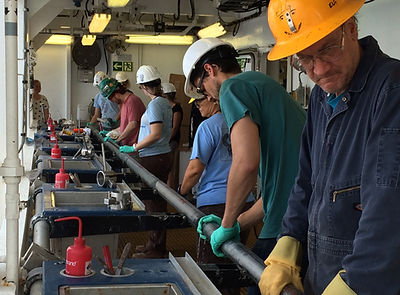
IODP Expedition 355
IODP Expedition 355 occurred in the spring of 2015 with scientific drilling in the Laxmi Basin offshore the Western continental margin of India. the objective of the cruise was to recover along section through the Indus submarine fan in order to reconstruct the varying intensity of the South Asian monsoon in the Western Himalayas as well as the erosional impact of the monsoon on the source mountains. We attempted to demonstrate whether there are links between monsoon intensification and the exhumation of high-grade metamorphic rocks in the Himalayas. An additional objective was the sampling of the igneous basement of the Laxmi basin in order to understand extensional processes during the opening of the Indian Ocean in the latest Cretaceous. As well as the submarine fan we recovered material from an extremely large mass wasting complex known as the Nataraja Slide which is derived from the North in the Saurashtra part of the Indian continental margin. This was emplaced shortly after 10.8 Ma and was up to 300 m thick in the location of our drill sites.
Meet The Team
IODP Expedition 355 Crew

Work during Expedition 355 involved 12 hour shifts, seven days a week for eight weeks of the expedition. In the photograph above we see the sedimentary geologists discussing the most recently retrieved core with co-chief scientist Peter Clift.


The expedition’s leadership, Dhananjai Pandey (left) from the Indian National Center for Antarctic and Ocean Research (NCAOR), Denise Kulhanek from IODP at Texas A&M University (staff scientist) and Peter Clift from Louisiana State University.
This photograph shows technicians from IODP processing the most recent call retrieved from the rig floor. They cut the 10 m long section into more easily handled 1.5 m sections which are then taken inside for description and analysis in the dedicated laboratories on the ship.




In the series above, the far right-hand photograph shows a graded muddy turbidite with deep water trace fossils grading up into him a pelagic carbonate which occasionally interrupts the section especially towards the top. Abandonment of the submarine fan by the Indus River likely reflects of motion of depositional lobes into the main Arabian basin to the west rather than a cessation of sediment supply from the river.
Examples of cores recovered during the expedition. On the extreme left -slump folded calcareous mudstones show ductile deformation during the placement of the mass transport deposit. To the right of that photograph we see debris flow conglomerates dominated by shallow water limestones derived from the edge of the western continental margin of India but also including fragments of Deccan plateau volcanics.
The right two photographs show sediments from the in the submarine fan, laminated fine sands interbedded with dark mud with parallel lamination indicating high-energy current activity during the emplacement of a turbidite deposit originally sourced from the Indus River mouth.


